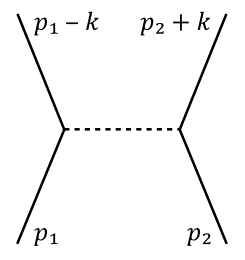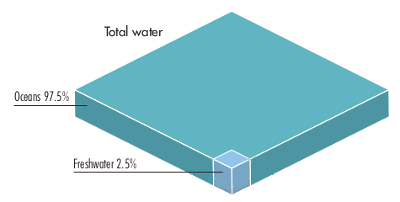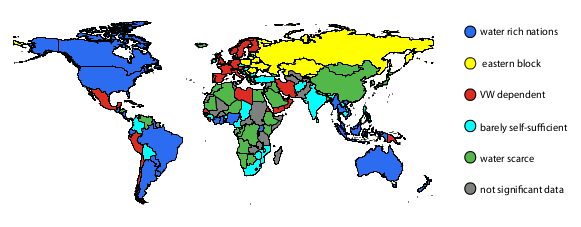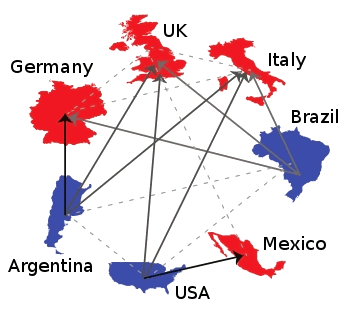Virtual Water
March 4, 2013
Readers of this blog will likely remember
virtual memory, the savior of
personal computing in the days before abundant and inexpensive
memory chips. Virtual memory allowed
magnetic disk storage to be a seamless extension of a computer's working memory space. Virtual memory worked adequately, until memory usage became so great that
thrashing occurred. It was easy to diagnose this problem, since
hard disk drives in those days made a lot of noise.
Wikipedia has a
list of the many things described as virtual. These include
virtual ground, beloved of
analog circuit designers like me,[1]
virtual reality; and
virtual colonoscopy, which is very close to what a
Star Trek version of this examination might be, but still not as thorough as
the real thing.
There are a few virtual items in
physics, including
virtual work, which, surprisingly, doesn't concern
Wally. The
Dilbert character, Wally, bears a close resemblance to one of my
undergraduate physics
professors. In his defense, my professor did quite a bit of "real" work, he supervised my
independent study, and he further facilitated my entré into
graduate school. There's also the interesting concept of
virtual particles.
Virtual particles exist because of the inherent uncertainty of
quantum mechanics, succinctly expressed by the
Heisenberg uncertainty principle
σp σx ≥ h/4π
in which
σp and
σx are the
standard deviations of
momentum and
position, and
h is
Planck's constant. The
time (T)-
energy (E) equivalent of this formula (usually expressed as
ΔE ΔT ≥ h/4π, although this is a simplification) reveals the magical property that
particles can come into existence for short periods of time out of nothingness. "Real" particles can interact with each other through an exchange of of a virtual particle. These interactions can be pictured in
Feynman diagrams, an example of which is shown in the figure.

Feynman diagram for exchange of momentum k between particles with initial momenta, p1 and p2.
In the case of electrons interacting electromagnetically, the momentum transfer is effected by a virtual photon, shown by the dashed line.
(Via Wikimedia Commons))
Empty space is not that empty, as
Paul Dirac theorized. It can be visualized as a background of pairs of virtual electrons and virtual
positrons, eponymously named the
Dirac sea. The Dirac sea explains some strange properties of the
vacuum, such as
vacuum polarization.
Now that we've summarized the more technical virtual objects, it's time to get to a currently important topic in a world becoming increasingly starved of
potable water; namely, the concept of
virtual water. Virtual water is water used in the growth, harvesting and packaging of food, or the
manufacture of
commodities.
Virtual water is important, since it depletes
water resources, and it's most important when these items are shipped outside of a country; that is, the country is
exporting its water, often without realizing it. Such water export has currency, since we may be facing the prospect of
peak water as a complement to
peak oil. I reviewed some of the world's water problems in a
previous article (The Water Equivalent of Energy, June 1, 2010).
It's projected that 1.8 billion people will face water scarcity by 2025, at which time two thirds of the
world's population may be subjected to water stress.[2]
China, which has
polluted about seventy percent of its water supply, is likely to run out of fresh water by 2030.[3] The
2030 Water Resources Group states that competing demands for water resources may lead to an estimated 40 percent supply shortage by 2030.[4]

Water, water,
every where,
Nor any drop to drink.
(A portion of figure 4.1, slightly modified, from ref. 2.)
The concept of virtual water was invented in 1993 by
John Anthony Allan, a professor at
King's College London. His focus at that time was on the
arid and
semi-arid Middle East, and he suggested that countries there could "
import" water by importing food.
As an extreme example, about 1,600
cubic meters of water are needed on average to produce a
metric ton of
wheat. It takes
gallons of water to produce an
integrated circuit.
Israel exports a lot of water when it exports
citrus fruits to
Europe. Water deficient countries would save considerable water by importing
meat, since
livestock are fed
grain with considerable virtual water content.
Physicists from the
University of Padua have teamed with
environmental scientists from the
École Polytechnique Fédérale de Lausanne in a paper on virtual water recently posted on
arXiv.[5] Their paper is an analysis of the global water imbalance and a caution about export policy and the food trade.

Dependency of countries on local and virtual water from data for the years 1996-2005. The political situation in the former Soviet Union during that time made analysis of that data more difficult. (Figure 1 of ref. 5.)
The primary point of the analysis is that water-rich countries will likely reduce their export of virtual water in the future, leaving water-poor countries at risk. The authors propose the following mitigating scenarios.[5]
(1) Cooperative interactions among nations whereby water rich countries maintain a tiny fraction of their food production available for export.
(2) Changes in consumption patterns.
(3) A positive feedback between demographic growth and technological innovations.
The first two points are
political solutions, whereas the last point is a call for more
R&D. I place more faith in the R&D solution than politics.

Go with the flow.
Net flow of virtual water between selected countries
(Figure 2, modified, from ref. 5.)
![]()
References:
- Dev Gualtieri, "Driven Shield Enables Large-Area Capacitive Sensor," Electronic Design, Jan. 15, 2013.
- Russell Arthurton, et al., Chapter 4 - "Water" from Global Environmental Outlook - GEO4 environment for development, United Nations Environment Programme, 2007 (23.5 MB PDF file).
- Cherian Thomas, Unni Krishnan and Sophie Leung, "China-India Water Shortage Means Coca-Cola Joins Intel in Fight," Bloomberg Online (May 26, 2010).
- Charting our water future, 2030 Water Resources Group, 2009.
- Samir Suweis, Andrea Rinaldo, Amos Maritan and Paolo D'Odorico, "Virtual water controlled demographic growth of nations," arXiv Preprint Server, January 29, 2013.
Permanent Link to this article
Linked Keywords: Virtual memory; personal computing; random-access memory; memory chip; magnetic disk storage; thrashing; hard disk drive; Wikipedia; list of the many things described as virtual; virtual ground; analogue electronics; analog circuit; designer; virtual reality; virtual colonoscopy; Star Trek; colonoscopy; physics; virtual work; Wally; Dilbert; undergraduate; professor; independent study; graduate school; virtual particle; quantum mechanics; Heisenberg uncertainty principle; standard deviation; momentum; position; Planck's constant; time; energy; elementary particle; Feynman diagram; electron; electromagnetic radiation; photon; Wikimedia Commons; empty space; Paul Dirac; theoretical physics; positron; Dirac sea; vacuum; vacuum polarization; drinking water; potable water; virtual water; manufacturing; commodity; water resources; export; peak water; peak oil; world population estimate; China; pollution; 2030 Water Resources Group; The Rime of the Ancient Mariner; Water, water, every where, Nor any drop to drink; John Anthony Allan; King's College London; desert climate; arid; semi-arid climate; Middle East; import; cubic meter; metric ton; wheat; gallon; integrated circuit; Israel; citrus fruit; Europe; meat; livestock; grain; physicist; University of Padua; environmental scientist; École Polytechnique Fédérale de Lausanne; arXiv; former Soviet Union; politics; political; research and development; R&D.